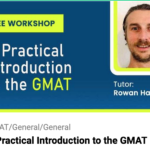GMAT Sentence Correction Tips — GMAT Grammar Tips and Rules for SC
GMAT sentence correction tips main page
The beauty of Sentence Correction on the GMAT is that it’s one of the easiest places to increase your score rapidly. In fact, you can make a huge amount of progress in a relatively short amount of time.
The best thing about GMAT Sentence Correction, however, is that there’s something for everyone.
It’s pretty rare for me to meet a client who doesn’t have at least some low-hanging fruit in Sentence Correction.
Whether you’re a native English speaker who’s too cocky about your own grammar abilities or you’re a non-native who’s worried that your English grammar isn’t at a sufficient level to succeed at GMAT Sentence Correction, this page will have some resources to help you out.
Let’s start with the Native English Speaker and GMAT Sentence Correction
- If this isn’t you, you can skip to the next section.
- If you’re not a native speaker but are highly fluent-to-bilingual, this is for you as well.
Native English Speakers have traditionally been the bread and butter of the GMAT. The test is nearly 70 years old, and for most of that time it was isolated to the United States, where English–or some strange offshoot of it–is the dominant language.
Of course for most of this time, the majority of the people taking the GMAT were born and raised speaking English. This landscape has of course shifted dramatically in recent decades to where a substantial proportion of GMAT-takers are not in fact native English speakers.
What, even, is the point of making this distinction?
Simple: Native Speakers tend to say things like “I’ve been speaking this language my entire life and I understand how grammar works” (while then saying crap like “That wouldn’t be true for her and I.” Right).
Native Speakers don’t tend to realize that there are actually many grammar errors baked into the way that we normally speak, and the GMAT loves to punish people for glossing over such errors.
Remember, what “sounds good,” or worse, “sounds normal” has little to do with what is correctly written.
The advantage that native speakers have is that some reasonably complex, difficult, idiomatic, or otherwise arbitrary constructions (e.g. subjunctive, negative limiters, etc.) can sound just fine to the ear where they might sound wildly incorrect to the non-native.
GMAT Sentence Correction for Non-Native Speakers
One does not have to be a stellar English speaker to do well on GMAT Sentence Correction. I mean that probably helps, but it’s no excuse that has any reason to hold you back.
Rather, non-natives have a huge advantage with GMAT Sentence Correction because you have actually learned English from books. You have had to study grammar at some point in the past, and that means that you actually have some idea of how English grammar works.
And let’s be honest: most of us native speakers really don’t have the first bloody clue about how English grammar actually functions: we just do it, holding our noses and hoping for the best.
SO… what to make of this?
The analytical side of English is something that doesn’t come easily to native speakers, so being able to break down and understand a sentence by its constituent parts is something where book learning can be helpful.
In my experience, most people whose English is sufficient to consider taking the GMAT in the first place have sufficient English skills to do well on GMAT Sentence Correction. The problem mostly lies with mindset: essentially, if you think you can’t do it, you’ll find reasons to support that hypothesis.
In other words, it’s a good excuse if you want to confirm to yourself why you’ll never succeed–but it’s not valid. In fact, anecdotally, many of my top SC students have been non-native speakers.
There might be a few tricky rules to learn, but GMAT Sentence Correction is a largely analytical process and is eminently learnable.
GMAT Sentence Correction Tips That are Common to Everyone
There are a lot of things to get used to on in GMAT Sentence Correction, many of which aren’t necessarily in standard grammar textbooks.
Sure, your basics such as sentence structure, verb tense, and all those sorts of things are pure grammar, but a lot of what is considered “GMAT grammar” is either stuff that is idiomatic, such as phrasal verbs and noun-preposition combinations, or it is stuff that the GMAT simply doesn’t like, such as excessive pronouns, nominalization, or redundancy.
At the end of the day, the most important thing for you to focus on is how you can best answer the question at hand: what that means is looking at the sentence through different lenses or filters.
The Filtering System to Beat GMAT Sentence Correction
Ultimately, what you’re trying to do is to use different reasons to eliminate different answer choices.
I suggest that when you go through answers in practice (and even in the test if you feel like that would be helpful), you make a quick note about WHY you think the incorrect answer is incorrect.
The way to do this is to think about the general reasons that something might be incorrect, or to apply different “filters” to your SC work.
In principle, what you’re looking for, then is to apply the individual filters one after the other until you have cross-applied enough filters that only one answer choice remains. In practice, admittedly, it’s not always that easy.
The Big 10 Filters that I use:
- Sentence Structure
- Verb Structure
- Pronoun Structure
- Comparison Structure
- Modifier Structure
- Verb Tenses
- Parallelism
- GMAT Idiom
- Redundancy
- Stuff GMAT Hates
This is of course an imperfect science, and there may be more things to discuss than these, but it’s a reasonable start.
Let’s start our GMAT Grammar Tips Filters section with Sentence Structure.
Sentence Structure
This one might be straightforward or it might not.
First, do you have a complete sentence with a subject and verb? Usually what I try to do is isolate the simplest functional sentence within a more complex sentence. I call this the Core Sentence.
Surprisingly, perhaps, what you’ll notice is that in many cases, the incorrect answer choices do not have a functional core sentence.
Look at this example (INCORRECT):
Although appearing less appetizing than most of their round and red supermarket cousins, heirloom tomatoes, grown from seeds saved during the previous year—they are often green and striped, or have plenty of bumps and bruises—heirlooms are more flavorful and thus in increasing demand.
Core sentence:
Although appearing less appetizing than most of their round and red supermarket cousins, heirloom tomatoes, grown from seeds saved during the previous year—they are often green and striped, or have plenty of bumps and bruises—heirlooms are more flavorful and thus in increasing demand.
This is clearly nonsense–note how we need the first “heirloom tomatoes” simply so we know what we are talking about, but it’s actually within parenthetical commas; this creates the problem of “heirloom tomatoes–heirlooms” when we look at the Core Sentence.
HOWEVER, when we look at the correct answer from among the answer choices, notice that that the Core Sentence is absolutely functional.
Example (CORRECT):
Although heirloom tomatoes, grown from seeds saved during the previous year, appear less appetizing than most of their round and red supermarket cousins—they are often green and striped, or have plenty of bumps and bruises—heirlooms are more flavorful and thus in increasing demand.
Make sure you’re using your commas and semicolons correctly. If you don’t know how to use a semicolon, then you don’t know how to use a period (full-stop). The test is that if you could fit a period in this place, it must be a semicolon rather than a comma.
Past this, there isn’t much more to Sentence Structure.
GMAT Sentence Correction Tips — VIDEOS
Sentence Correction Resources
Last Minute GMAT Grammar eBookVerb Structure:






